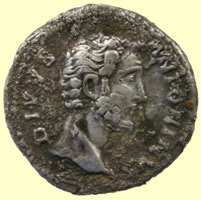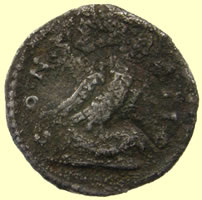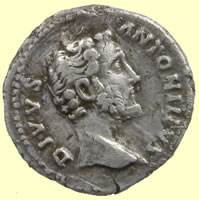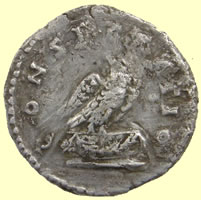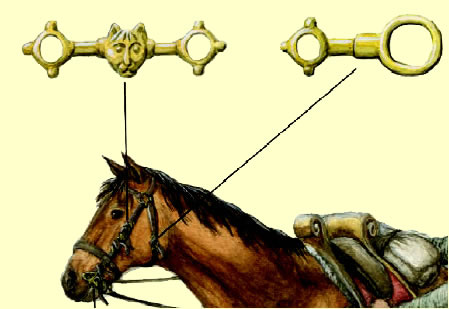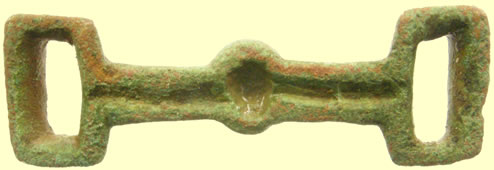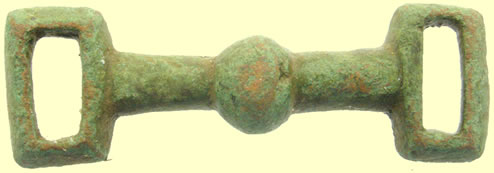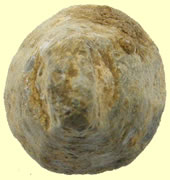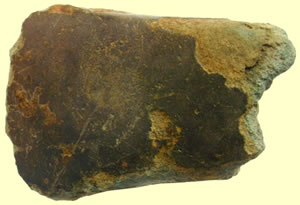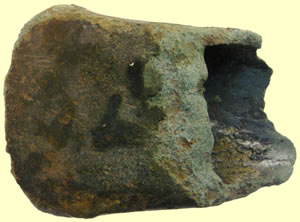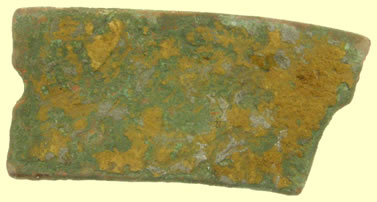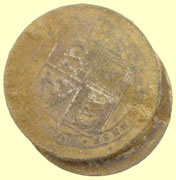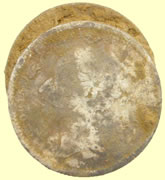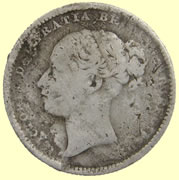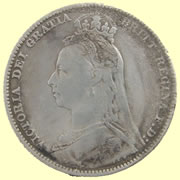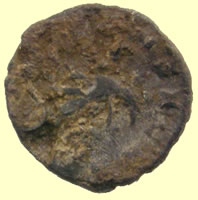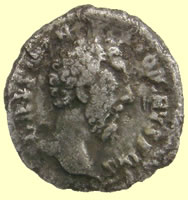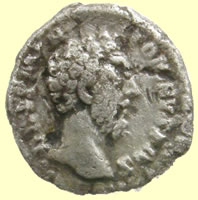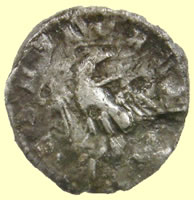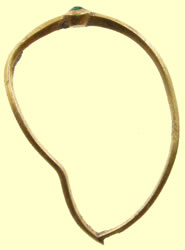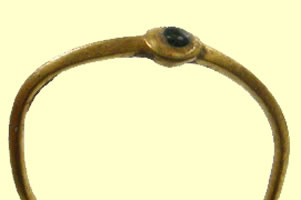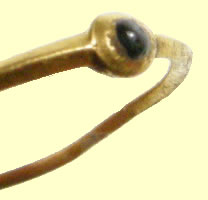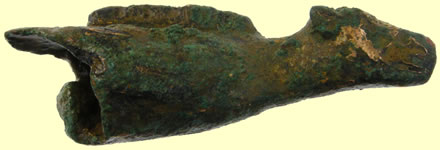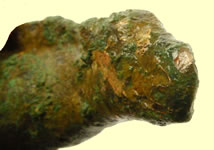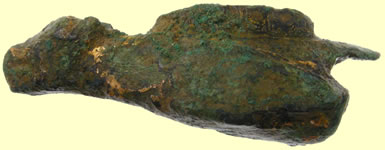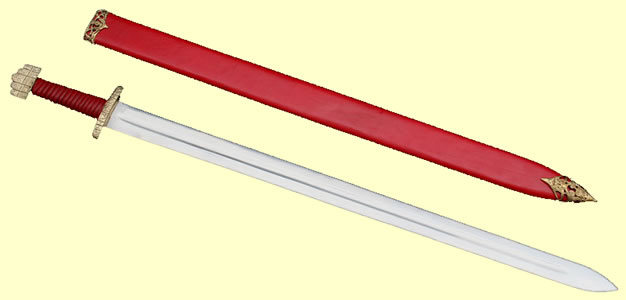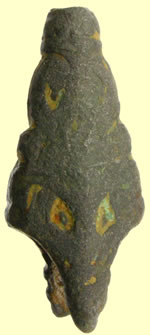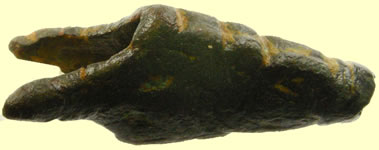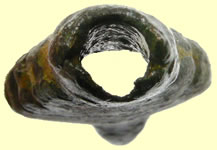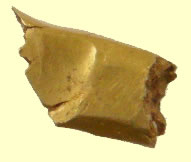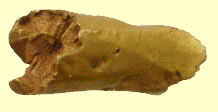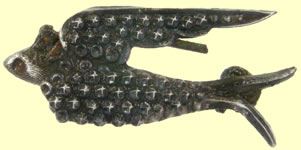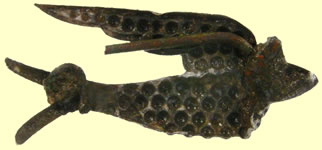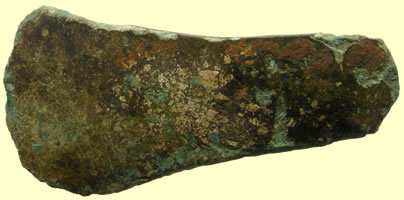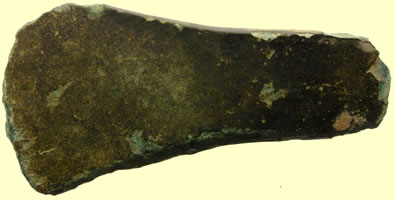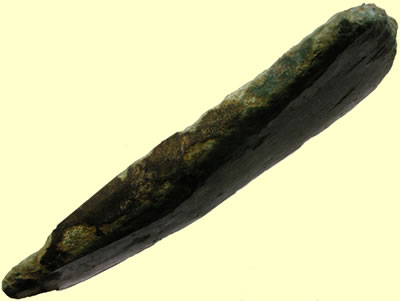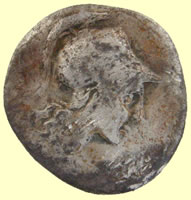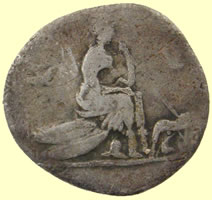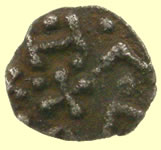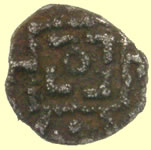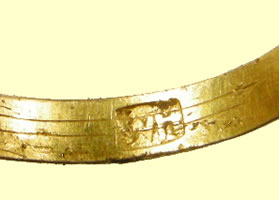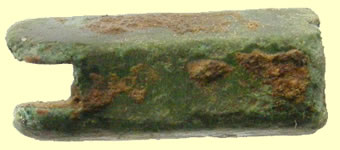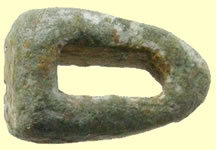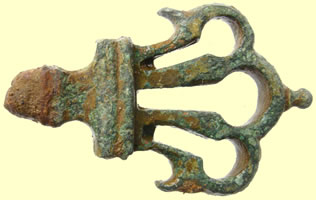

Metal detecting holidays in England with the World's most successful metal detecting club.
Twinned with Midwest Historical Research Society USA
2011 Feb finds page |
|||||||||
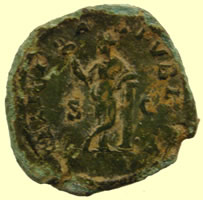 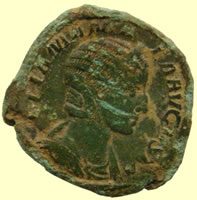 |
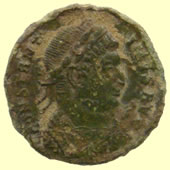 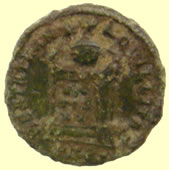 |
||||||||
3ndC Roman coin sent for ID 23.36g, 34mm he "As" (depending on size, it might be a sestertius) is Julia Mamaea, mother of Severus Alexander, 222-235 AD. (and the real power behind the throne). The reverse type is FELICITAS PVBLICA with Felicitas cross-leggedly lounging against a conveniently located short column, holding a caduceus. It's known in at least 2 different sizes - Sestertius and Dupondius/As. Since the bust is not on a crescent, we can rule out Dupondius, so depending on size, it's either an As or a Sestertius. This type dates to 228 AD. Here's a photo of a Sestertius of the same type in my collection - http://www.stoa.org/gallery/album97/ML_20_J_Mammaea_Felicitas_sest Mark |
4thC Roman coin sent for ID The 3rd piece is Constantine I (The Great, 307-337 AD.), a reduced-module Follis. Your photography is not quite up to its usual standards on this one - particularly the reverse, so I can't be certain which mint it's from, but I think I see TRS• in the exergue. If so, it's from the mint of Trier. The reverse type, BEATA TRANQVILLITAS (Blessed Tranquility!) with 3 stars above the Orbis Terrarum atop a short altar inscribed VO / TIS / X X, dates to approximately 321-323 AD. If I could get an accurate read on the letters (and possibly a dot or dots, and/or crescent) in the exergue, I could probably pin it down closer - to a single year. On this coin, Constantine is portrayed in what is called "Consular Style", wearing Trabaea (Imperial mantle) rather than the usual cuirass & drapery, and holding an eagle-tipped scepter. This same type was struck at all the Western and Northern mints in addition to Trier (including London) during this approximate time-frame, early 320's AD.
Mark
|
||||||||
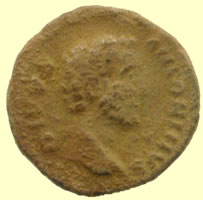 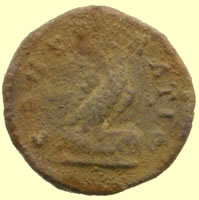
|
|||||||||
2ndC Roman silver coin as dug and partially 'cooked' to reveal some of the detail 3.14g, 19mm The Denarius is a poshumous commemorative issue in remembrance of Antoninus Pius, by Marcus Aurelius, c. 161, AD. "DIVVS ANTONINVS / CONSECRATIO"; eagle on garlanded altar. Mark |
|||||||||
1stC BC to 1stC AD Celtic Woad cosmetic grinder - boat shaped with broken suspension loop |
|||||||||
A cast copper-alloy strap-fitting from a medieval horse harness. It is sub rectangular, with a rectangular loop at one end Bridle cheek piece. The square attachment loop suggests an 11th- to 12th-century date Date from: Circa AD 1066 |
|||||||||
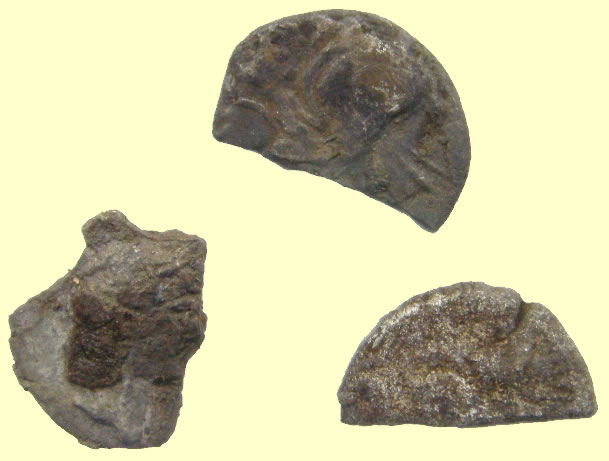 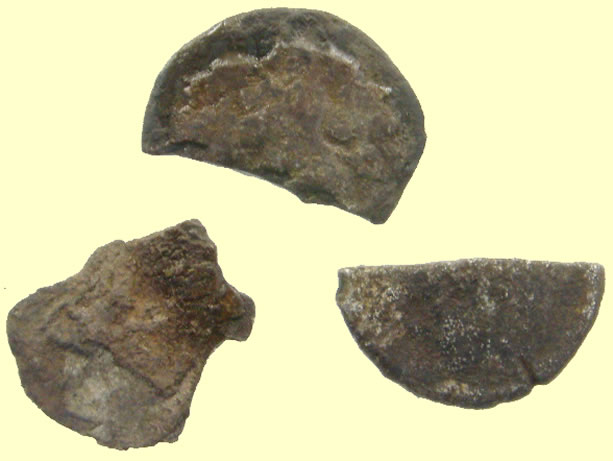 |
|||||||||
Roman silver coin fragments 'cooking' since Nov to break down horn silver crust. Top one is a Roman Republican BC period. Bottom left is the one I discovered mixed in with a guys buttons in his export pouch - it has a great detailed bust showing through |
|||||||||
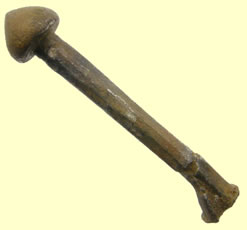 |
 |
|
|||||||
15thC Medieval knopped silver spoon handle - reported as treasure to museum
|
1500-1650 buckle |
Post medieval lead hanging weight |
|||||||
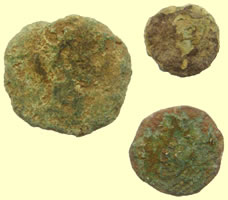 |
 |
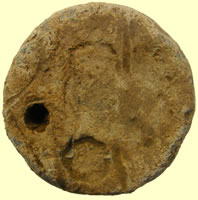 |
|||||||
2nd to 4thC Roman 'grots' |
18thC Navy lead token |
17thC Plummers company hallmarked trade weight - this weighs exactly 1Ib (16 oz's) on my digital scales - amazing accuracy to make this lump of lead within 3 decimal places |
|||||||
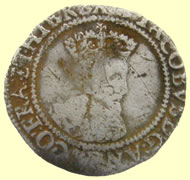 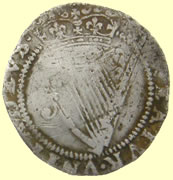
|
|||||||||
1603-1604 Irish James 1st hammered silver sixpence - First coinage Obv JACOBUS D.G. ANG SCO FRA ET HIB REX Rev TUEATUR UNITA DEUS |
|||||||||
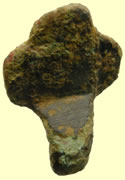 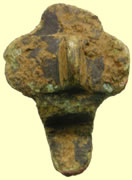 |
 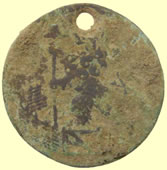 |
||||||||
c6th to 10thC Saxon trefoil brooch |
1766 Dutch - Holandia copper coin |
||||||||
850BC Bronze age socketed axe |
|||||||||
Very interesting large plaque find - Tenn Brad thinks it is 'The script is gothic textura prescisus vel sine pedibus. 13th-14th century' in Latin 'that bronze piece with two lines of Latin looks very much like the edge piece of a paten. The plate used in eucharest'. lilatte Polt nlefl Mi Ex dono Revernd mi Patris in Christo Sam Providentia Divina Tuamensis ... +SVMMITVR HINC NVNDA DIVINI SANGVINIS VNDA |
|||||||||
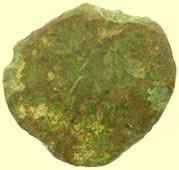 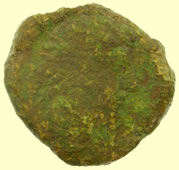 |
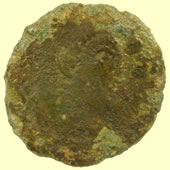  |
||||||||
2ndC Roman bronze coin sent for ID The 1st one here is (I'm almost completely sure) a Marcus Aurelius with winged thunderbolt reverse. These typically date to fairly late in his career as Augustus - the late 170's AD. But I'm not sure what the denomination is. I couldn't quickly find an example of an As with the winged thunderbolt reverse, only a Dupondius. However, it doesn't appear that Aurelius is wearing the radiate crow of Helios/Sol - and all his Dupondii are radiate - so I'm a little uncertain about the denomination, but it surely is Marcus Aurelius and a winged thunderbolt reverse. Mark |
4thC Roman bronze coin sent for ID The large Christogram reverse is typically associated with Magnentius & Decentius, although it is also known for Constantius II. I'm pretty sure this is one of the pair of brothers (probably Magnentius as his coins are a lot more common then Decentius') - they're always portrayed with no headgear and rather silly-looking "mullet" hairdos. I can't give you a mint on this one - it's not clean enough - and I suspect the exergue is off flan due to being off-center "to the South" a bit. Their time frame was 350-353 AD. and all their coins were from Western mints - they were not recognized in the East.
Mark
|
||||||||
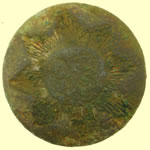 |
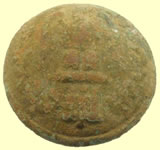 |
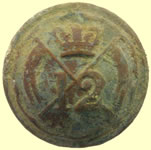 |
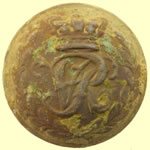 |
||||||
|
33rd Regiment of foot button 1782-1810 |
19thC Essex Regiment button |
|
19thC Victoria Rex Engineers button |
||||||
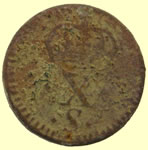 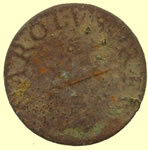 |
 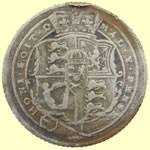 |
||||||||
1634 Charles 1st 10 shilling coin weight - Crown Xs cipher |
1817 George III milled silver sixpence |
||||||||
  |
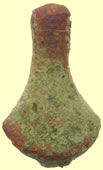 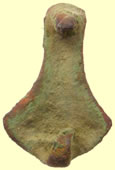 |
||||||||
1500-1700 mount |
1500-1700 mount |
||||||||
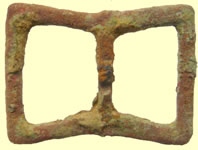 |
 |
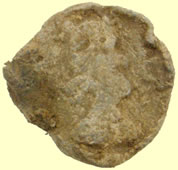 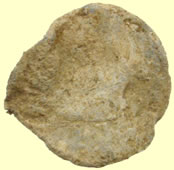 |
|||||||
1500-1650 buckle |
'Fish brothers' watch winder |
Roman lead token |
|||||||
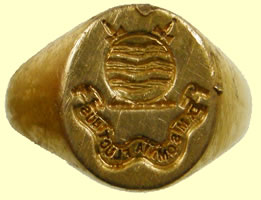 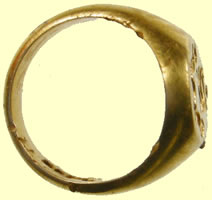 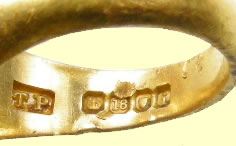 |
|||||||||
12.45g - 18 carat gold seal ring - very tricky to date as the assay office mark is worn and appears to be Chester.- the crown 18 carat mark was introduced in 1790 and the date letter style 'i' best suits 1784 although the lower case 'i' was also used in 1872. It is probably 1872 because of the crown 18 mark. I cannot find the maker T.P listed Tenn Brad is deciphering the latin inscription |
|||||||||
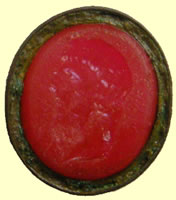 |
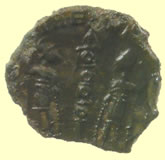 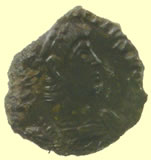 |
||||||||
Georgian intaglio |
Mint mid 4thC House of Constantine Roman bronze sent for ID |
||||||||
  |
  |
||||||||
1603 James 1st hammered silver penny |
Mid 4thC House of Constantine Roman copper |
||||||||
  |
  |
||||||||
Gilded Lion Army lapel badge |
Asian looking pendant |
||||||||
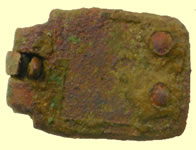 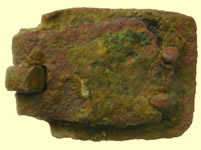 |
  |
||||||||
Medieval buckle plate |
Saxon bow brooch |
||||||||
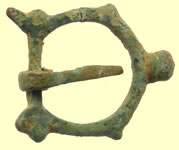 |
 |
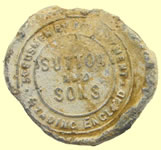 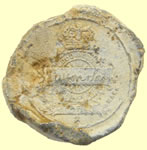 |
|||||||
1500-1650 buckle |
1500-1700 buckle |
Post medieval lead bale seal |
|||||||
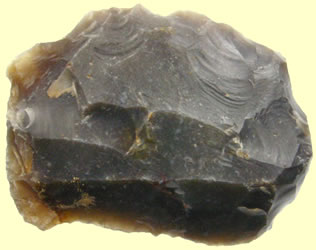 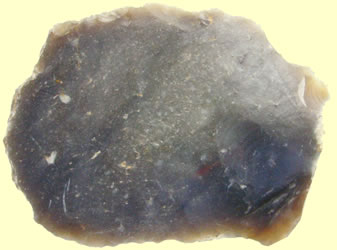 |
|||||||||
11,000 BC Stone Age flint scraper |
|||||||||
  |
 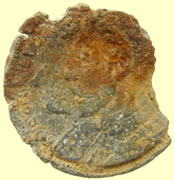 |
||||||||
1341 Edward III hammered silver florin penny London mint |
1911 George V to Queen Mary marriage medallion |
||||||||
 |
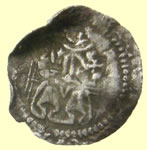 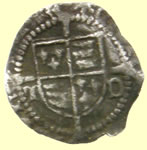 |
||||||||
Lots of 4thC Roman 'grots' turning up |
1493-5 Henry VII hammered silver sovereign penny - RD by shield -Durham mint - Bishop Sherwood |
||||||||
  |
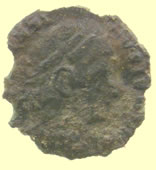  |
||||||||
Taco'd 16thC Elizabeth 1st hammered silver penny |
4thC House of Constantine Roman bronze sent for ID |
||||||||
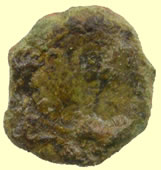 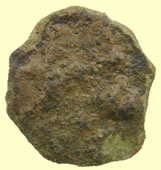 |
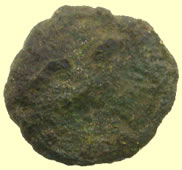 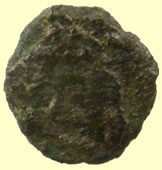 |
||||||||
4thC House of Constantine Roman bronze |
4thC House of Constantine Roman bronze |
||||||||
As dug 2 silver coins stuck together - old and new bust Victorian shillings
1883 Victoria milled silver shilling (12 pence)
1892 Victoria milled silver shilling (12 pence)
|
|||||||||
|
|||||||||
Roman silver coin - as dug and partially cooked - back in the 'cooker' to remove crust It's posthumous commemorative for Marcus Aurelius issued under Commodus c. 181-2 AD.
I know it's not easy to see yet, but the reverse is an eagle, standing left with wings open and head turned to the right - ie, you have the photo almost exactly upside-down here.
I think the reverse of the Antoninus Pius denarius was similar, although the exact attitude of the eagle may be different.
Although the eagle is facing the opposite way, this is a sestertius from that same series in memory of M. Aurelius http://www.stoa.org/gallery/album94/ML14_M_Aurel_Divus_Sest in fact it is exactly the same type, except for the direction the eagle faces.
Mark
|
|||||||||
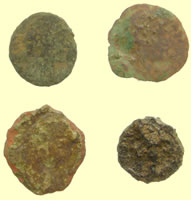 |
  |
||||||||
Rough mid 4thC House of Constantine Roman bronze and copper coins |
1413- 22 Henry V hammered silver halfpenny - early hair type Type 5 broken annulets by crown Obv +hENRICxREXxANGL Rev CIVI/TAS/LON/DON - London mint |
||||||||
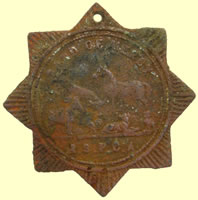 |
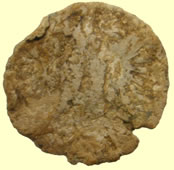 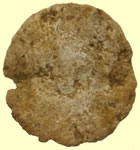 |
||||||||
Neat RSPCA badge - Royal society of protection of cruelty to animals |
17thC lead token - double headed eagle |
||||||||
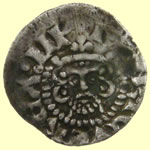 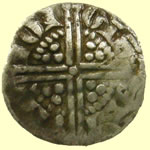 |
  |
||||||||
1247 Henry III hammered silver long cross penny - Class IIIb Rev - ION/ON/ GLO/VCE -Moneyer Ion of Gloucester mint |
4th/5thC Roman silver coin - 'cooking' it to bring out detail |
||||||||
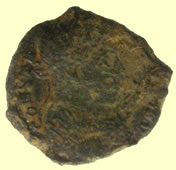 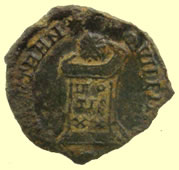 |
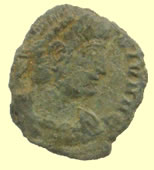 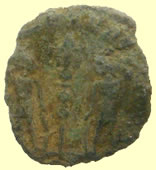 |
||||||||
4thC House of Constantine Roman bronze sent for ID The BEATA TRANQVILLITAS - 3 stars above a globe atop an altar inscribed VO / TIS / XX - of Constantine I appears to be from the mint at Trier. This is one of the earlier mass issues in the "Constantinian" era. Dating to the early 320's, they come just after the VLPP's and VIRTVS EXERCIT types and immediately precede the "campgate" types. This one is clear enough to show the "bands" on the globe and make it relatively certain to be meant to represent the "Orbis Terrarum", or the celestial sphere surrounding the Earth. Mark |
4thC House of Constantine Roman bronze sent for ID There isn't quite enough detail on the reverse to be sure which mint it's from, but the single-standard GLORIA EXERCITVS here names Constantine II in a relatively uncommon obverse legend ending "...IVN N C" Only Constantine II ever had IVN in his title and the use of N C instead of NOB C or NOB CAES is limited to a few of the Western European mints - Trier, Arles & Rome. Mark |
||||||||
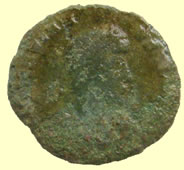 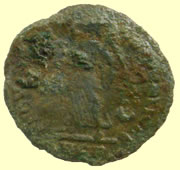 |
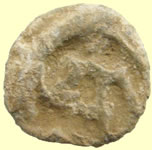 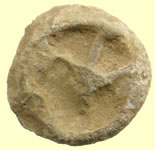 |
||||||||
4thC House of Constantine Roman bronze sent for ID The second on this page, with reverse type, Victory walking left holding wreath and palm, is from after the end of the Constantinian era. I believe it names Gratian, 367-383 and I also believe it's from the mint at Lyon, although the mint mark isn't very clear and the GLORIA ROMANORVM & SECVRITAS REIPVBLICAE types introduced in the Valentinian Dynasty were among the first to employ a really complex field-and-mint mark control system, so there are an enormous number of combinations for each mint combining various marks in the fields and exergue.
Mark
|
Roman lead token |
||||||||
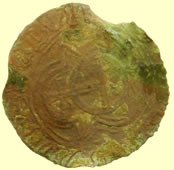 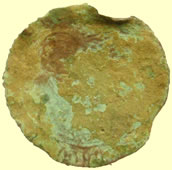 |
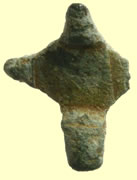 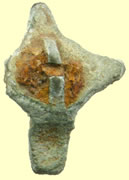 |
||||||||
1586 Hans Krauwincel II Rose orb Jeton HANNS KRAVWINCKEL IN NVRENB |
C10thC Saxon brooch |
||||||||
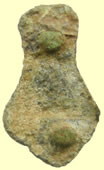 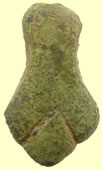 |
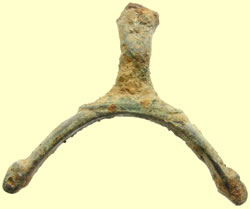 |
||||||||
Medieval mount |
17thC spur |
||||||||
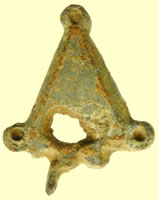  |
  |
||||||||
Very unusual medieval mount with suspension loop - possible early clothing fastener |
18thC silver button |
||||||||
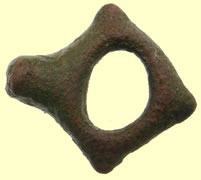 |
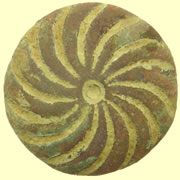 |
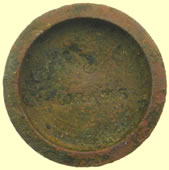 |
|||||||
C10thC Saxon harness cheek piece |
1500-1700 mount
|
Victorian 8 grams apothecary weight |
|||||||
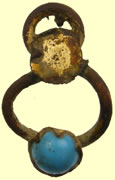 |
  |
||||||||
Victorian jewelry fragment |
1917 George V milled silver 3 pence |
||||||||
 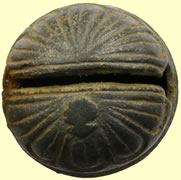 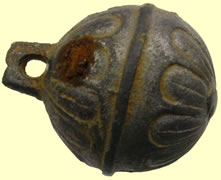 |
|||||||||
17thC crotal bell with head foundry mark |
|||||||||
 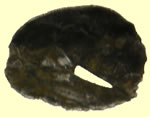 |
|
||||||||
Medieval long cross hammered silver farthing |
|||||||||
 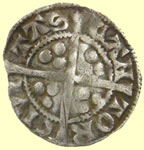 |
 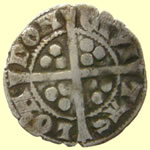 |
||||||||
1341 Edward III hammered silver Florin penny Obv EDWAR ANGLE DNS HYB Rev CIVI/TAS/CAN/TOR - Canterbury mint |
1341 Edward III hammered silver Florin penny Obv EDWAR ANGLE DNS HYB Rev CIVI/TAS/LON/DON - London mint |
||||||||
 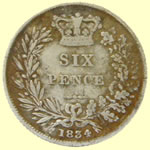 |
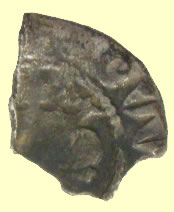 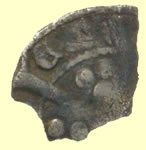 |
||||||||
1834 William IV milled silver sixpence |
Edward 1st to 3rd hammered silver penny Obv EDW******** Rev /EBO/*** - York mint |
||||||||
C14thC medieval emerald gold ring - reported as treasure to the museum 0.48g, 14.54mm |
|||||||||
   |
|||||||||
Stunning 2nd C Roman enameled Trumpet headed fibular brooch - Hattatt Page 329 Fig 188, 449 |
|||||||||
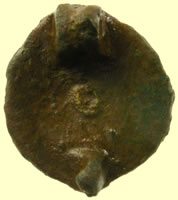  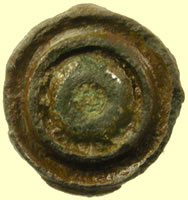 |
|||||||||
Anglo Saxon disc brooch of the Middle period C9thC - some silvering remains Hattatt Page 379 |
|||||||||
 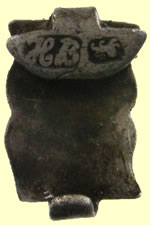 |
|||||||||
1761-1780 18thC decorated silver clog fastener Hester Bateman First recorded English woman silversmith London Assay office Hester Bateman is without doubt the most popular and renowned of all women silversmiths. Yet Hester's career as a silversmith was never intended. Widowed at the age of 51, she inherited her husband's small workshop practice and for the next thirty years, this unlikely shrewd business woman, grew the workshop into a thriving silver manufacturing firm. Hester Bateman was born in 1704 in Clerkenwell, London (England), and married John Bateman (a goldsmith) in about 1725. They had six children; John, Letticia, Ann, Peter, William, and Jonathan. The family lived at 107 Bunhill Row in the Parish of St. Luke in North London for more than a century. John and Hester purchased the houses on both sides of theirs, and two of the children occupied those homes in later years. Although his sons Peter & Jonathan were both doing their silversmithing apprenticeships, when John Bateman died in 1760, he bequeathed all his tools to Hester suggesting that she was already an accomplished silversmith. However, even with the skills of the trade, Hester had no small task ahead of her to continue the business. In these times, women-owned businesses were generally not accepted, and the industry was highly competitive. Unperturbed, Hester registered her mark of a scroll HB at Goldsmiths Hall in 1761 and aided by her son's Peter and Jonathan along with Jonathan's wife, Ann, the business boomed. In 1790, Hester finally retired at the grand old age of 81. Sadly, the following year her son Jonathan died, leaving Peter without his two long term partners. He turned immediately to his sister in law Ann, making her a partner in the business and registering their joint mark in 1791. From then Ann became the driving force in the business until her retirement in 1805. In 1800, Jonathan and Ann's son, William, became a partner in the family business, completing possibly the most famous of all silversmithing dynasties. Unlike most silversmiths who specialised in just one area of production, the Batemans were masters of many, producing fine wares right across the board. The main reason for their success was due to Hester's attention to design, detail and quality. All the pieces that left the workshop would be inspected to the highest standard and with this attitude the business grew. Many pieces of Hester Bateman's silver show identifying characteristics such as bead detailed edges and fine designs of bright-cut engraving. They received many commissions from The City Guilds, various religious establishments, and private individuals |
|||||||||
  |
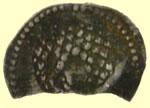 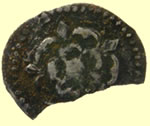 |
||||||||
c10thC Saxon harness cheek piece |
1603 James 1st hammered silver penny |
||||||||
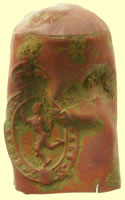 |
 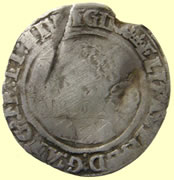 |
||||||||
WWII Royal Signals regiment baton end |
1567 Elizabeth 1st hammered silver sixpence |
||||||||
 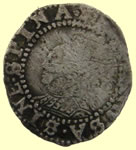 |
 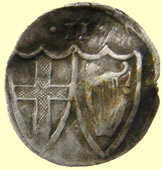 |
||||||||
1601-2 Elizabeth 1st hammered silver penny -1 mint mark |
1649 Commonwealth hammered silver half groat |
||||||||
 |
 |
  |
|||||||
19thC livery button |
1500-1650 buckle |
A complete copper alloy medieval bar mount. The copper alloy sheet bar is folded to create a loop and has a single or double rivet hole. Broad period: MEDIEVAL Date from: Circa AD 1300 |
|||||||
  |
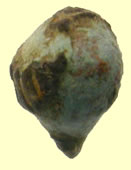 |
 |
|||||||
17thc decorated belt slide |
Roman decorated pin head |
Cast copper alloy mount of probable late medieval or post medieval date (1400-1600). |
|||||||
Roman dragon headed dagger chape- gilding and red enamel remains 66.96mm L ,43.91g |
|||||||||
Viking sword and scabbard with chape at end
Open mouthed beast zoomorphic type - red eyes
Viking style zoomorphic dagger chape 54.08mm L, 29.85g - red and green enamel remains |
|||||||||
 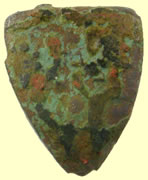 |
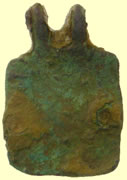  |
||||||||
Medieval heraldic shield mount - red and green enamel remains |
Medieval harness enameled heraldic pendant- Lion passant motif - gilding and red enamel remains |
||||||||
 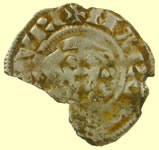 |
|||||||||
This a fascinating Scottish hammered silver coin as it does not match any in the ref books. All of the James 1st to V reigns have a legend starting IACOBUS The legend clearly reads MAR and the only match is Queen Mary 1542 - she issued long cross pennies with a crown in two angles and cinquefoil in other two angles. This coin has 3 pellets in 3 angles and star in 4th quadrant Could be an unknown issue - needs more research
|
|||||||||
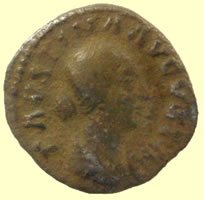 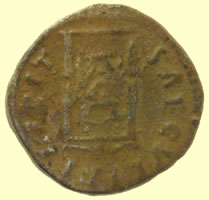 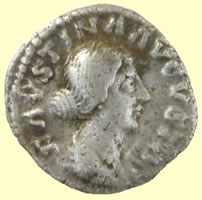 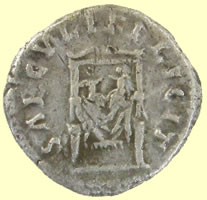 |
|||||||||
As dug and 'cooked' This is Faustina Junior (or "II", or "the Younger" - different sources title her differently). She was the daughter of Antoninus Pius and Faustina Senior and marrried Marcus Aurelius, Antoninus' adopted son and chosen successor soon after he was made Caesar, in 146 AD. and predeceased him by a few years in 175. Therefore, you have 3 separate "sources" of coinage for her. The first group of issues was authorized by Antoninus Pius and is thought to date to the period soon after her elevation to Augusta in 147. Marcus Aurelius issued coins in her honor after Antoninus' death as well as a large posthumous coinage towards the end of his reign. |
|||||||||
  |
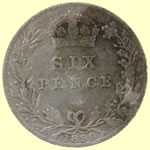  |
||||||||
1914 George V milled silver sixpence |
1899 Victorian milled silver sixpence |
||||||||
 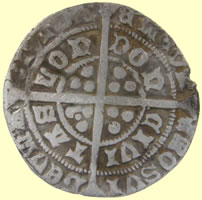 |
|||||||||
1471 -83 Edward IV hammered silver groat first reign light coinage -Type 5C - Trefoils on cusps except over crown - initial mark rose - quatrefoils by neck - Extra pellet under DON on reverse Obv EDWARD.DI.GRA.REX.ANGL.Z. FRANC Rev CIVI/TAS/LON/DON - London mint |
|||||||||
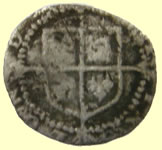  |
|
||||||||
Tiny 16thC Elizabeth 1st hammered silver half penny |
Ancient gold bar 3.80g, 12.71mm long reported as treasure to museum |
||||||||
 |
|
||||||||
WWI British Army officers training corp - Cambridge University |
Victorian silver brooch |
||||||||
 |
 |
|
|||||||
Royal Navy - Officers (Roped Rim) Lined Background 17.5mm 1843-1891
|
1550-1650 buckle |
17thC decorated ring |
|||||||
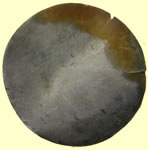  |
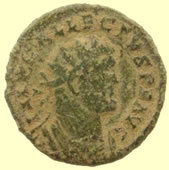  |
||||||||
Worn Medieval hammered silver penny - CIVI/TAS type |
Roman bronze coin sent for ID
2.83g, 18.50 As you can easily read, this is a coin of Allectus, 293-6 AD., the unsuccessful successor to the far more savvy British pretender, Carausius.
This piece is called a "Quinarius" - generally a term applied to a half-denomination - although what the difference might be between an Antoninianus and this radiate "Quinarius", I'm not altogether sure. It may be that this is an artificial distinction imposed through classification by later analysts who felt these smaller coins must be of a lower denomination. This piece with reverse type: VIRTVS AVG, galley left, and QC in exergue, is attributed to "Clausentum?" by Sear, to Camulodunum by RIC - same place, two different names? Or two different places? I really don't know enough about Roman-era British Geography to say - you can probably fill in the blanks here. There are several sub-types known, based on number of oars, etc.
It's a fairly common piece, but as you're probably aware, coins of the British Roman Empire, 287-296, are highly sought-after by modern-day British collectors. Here's a "clean" specimen, although displaying a bit more wear, of the same type from my own collection - http://www.stoa.org/gallery/album85/ML_09_Allectus_Virtus_ant2
Mark
PS - Unless I am mistaken, the huge Lord Selborne Blackmoor hoard was thought to be Allectus' war chest, buried for safekeeping just before his ultimate defeat by Constantius I.
|
||||||||
 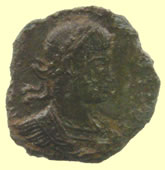 |
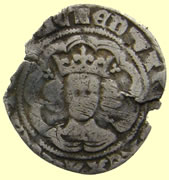 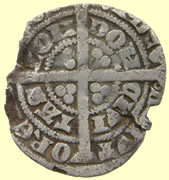 |
||||||||
Mid 4thC House of Constantine Roman bronze coin sent for ID - 1.44g, 16.31mm I'm not going to be able to say with certainty, but on the basis of the bust, this appears to be Constantine II as Caesar, although it could be his brother Constantius II. The GLORIA EXERCITUS, 2 soldiers flanking 2 standards type was struck at all mints during the period 330-335/6 AD. The exergual mint mark on this one is a bit unclear, but I think it's from the mint at Siscia - modern-day Sisak, near Split in Croatia.
Mark
I'll add a speculative attribution to mint based on some mint mark tables I have access to. If the 3rd character is a dot (as it appears it may be) chances are good this is a product of the mint at Trier. It seems as though - being about as close as any Roman mint of the era - a disproportionate number (for any other location) of the AE's you find are from Trier.
You presumably have the coin "in-hand" - if you'll look to see if the exergual mint mark is TR•S (as it appears it may be) you may be able to confirm or refute this guess.
Mark
|
1351-3 Edward III hammered silver half goat - Pre treaty Series C - no trefoils over crown, wedge tailed R, closed C & E Obv EDWARDVS REX.ANGLI.Z. FRANC Rev CIVI/TAS/LON/DON - London mint |
||||||||
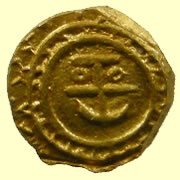 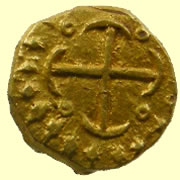 |
|||||||||
c 8thC Saxon gold coin - sent to Fitzwilliam museum for recording and ID Unusually thick coin for a Saxon 1.31g,9.51mm x 1.61mm thick Many thanks for this new coin, which I have recorded as EMC 2011.0044. Most 'Saxon' gold coins found in this country are Merovingian tremisses, and this is no exception to that rule. As you rightly say it is too thick to be Anglo-Saxon. The absence of an readable inscription is a problem and I have been unable to find an illustration of a similar coin in the reference books on Merovingian coins (not an unusual experience).
Best wishes, Martin |
|||||||||
 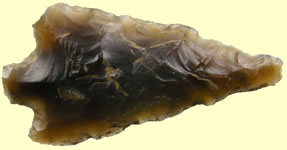 |
|||||||||
Stunning 8000BC flint arrow head |
|||||||||
2000 BC Early Bronze Age flat axe - 95.92mm L x 43.11mm W
|
|||||||||
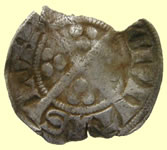 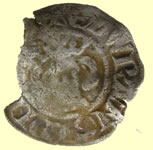 |
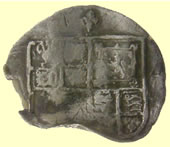 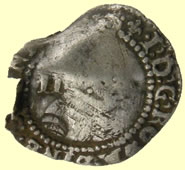 |
||||||||
1341 Edward III hammered silver Florin penny Obv EDWR ANGLE DNS HYB Rev CIVI/TAS/LON/DON - London mint |
1604-5 James 1st hammered silver half groat |
||||||||
 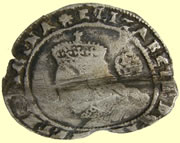 |
 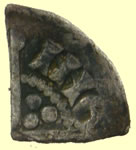 |
||||||||
1577 Elizabeth 1st hammered silver sixpence |
1247 Henry III hammered silver voided long cross cross 1/4 penny - Class IIIa-c Obv *** ENR ** - HENRICVS REX Rev **/NNE/** - Newcastle mint |
||||||||
 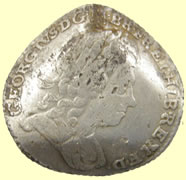 |
|||||||||
Rare find 1723 George 1st milled silver sixpence -SSC South Seas Company |
|||||||||
  |
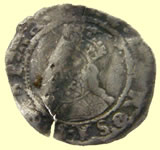 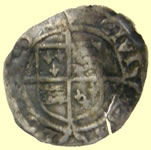 |
||||||||
1939 George VI milled silver half crown (30 pence) |
16thC Elizabeth 1st hammered silver penny |
||||||||
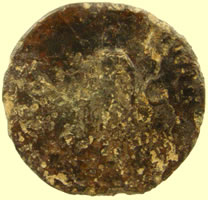  |
 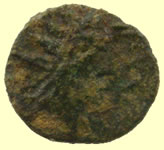 |
||||||||
Huge 2ndC Roman bronze sent off for ID This one is Trajan - 98-117 AD - Hadrian's immediate predecessor. I can't quite be sure about the reverse, but, as is very common for Trajan, the reverse legend appears to be S.P.Q.R. OPTIMO PRINCIPI S - C. This legend was coupled with an entire "pantheon" of deities, personifications, portrayals of the emperor, etc - ie: all the devices and types he used on all denominations' reverses over a period of years generally had the same base legend, although some few types might have an additional word (generally exergual) or words like "ITALIA" or "FORT RED" for Fortuna Redux.
Even though I can't be certain from the photograph, I strongly suspect from the attitude of the shoulders that this is the standard rendering of the personification Spes (Hope) walking to the left, holding a flower in her upraised right hand and hitching the skirt of her gown with the left. Spes was a commonly used and popular reverse type who appears in almost all eras, almost as often as Pax. You might even call Spes a "stock type".
Mark
|
Mid 4thC Barbarous radiate Roman bronze coin |
||||||||
 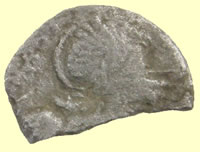 |
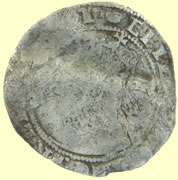  |
||||||||
Roman Republican BC silver coin fragment - more cooking to do on the Obv 18.21mm,1.95g sent for ID It is definitely a fragment of a Republican denarius, however we'll have to see some significant revelation on the reverse to have any realistic chance of ID'ing it further.
Mark
|
1593 Elizabeth 1st hammered silver sixpence |
||||||||
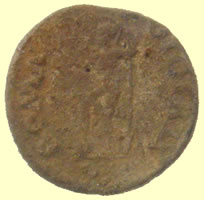 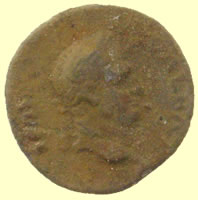 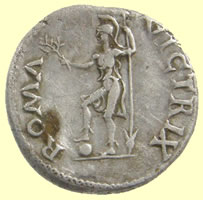  |
|||||||||
As dug and 'cooking' Roman silver coin straight into the 'cooker' - sent for ID Very rare find Of course I can't be certain in its present state of encrustation, but it appears you have found another Galba - one of the 3 very short-lived rulers in the chaotic year between Nero's suicide and the eventual triumph of Vespasian. Although Galba's coins are the more common of the three by a significant margin (Otho & Vitellius are far scarcer) having ruled the longest during that time, they're still not at all common compared to any other of the 1st century rulers' coins.
I'll be curious to see if my initial impressions were correct, but this appears to be a Galba Denarius with a ROMA RENAS[CENS] or ROMA VICTRIX reverse - and the coin, overall, appears to be in stunningly nice condition for a farm surface find.
You keep turning up coins of this quality and scarcity, I'm going to have to come over there and dig some, myself!
Mark
|
|||||||||
  |
|||||||||
1855 Victorian gold Sovereign |
|||||||||
|
|
||||||||
BC Roman republican silver - sent for ID 3.23g,20.52mm
This is a very interesting piece - both for the un-encrusted condition in which it was dug, and as a type. Dating to about 115/4 BC., this was an anonymous type produced well after the time when moneyer's names had become standard on the coins. The obverse is Roma wearing the typical winged and crested Corinthian-style helmet; an "X" to indicate denomination (a silver Denarius was worth 10 Æ Asses at the time) behind the head and ROMA beneath. The reverse shows Roma seated right on a pile of shields and holding a transverse spear. Birds, one per side, fly in the field; and to the right, the she-wolf suckles the twins, Romulus and Remus, so there's a lot going on here, symbolically.
David Sear writes in RC&TV, 2000: "An issue lacking the moneyer's name is surprising and noteworthy at such a late date. The omission must have been his own decision and not the result of a change in government policy. Remarkably, this distinctive reverse type was revived almost 200 years later on an aureus of Titus."
So, it's not the earliest piece your diggers have found, but it's still pretty early. Moneyers' names had become standard on the denarius coinage around 155 BC. and for the previous several decades most coins had born symbols relating to the moneyer's name or family in some way. This isn't a particularly rare piece, overall, but it is an unusual type.
The references for this piece are: RSC 176, CRR 530, RCC 287/1 & SR 164.
Mark
|
Saxon C600-775 AD Silver Sceat 1.12g,11.99mm sent for recording and ID sceat (EMC 2011.0045) , which is Series D (Type 8) and presumably Frisian. Best wishes, Martin |
||||||||
  |
  |
||||||||
1603-4 James 1st hammered silver halfpenny |
1921 George V milled silver Florin (24 pence) |
||||||||
 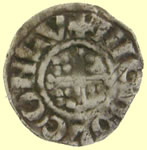 |
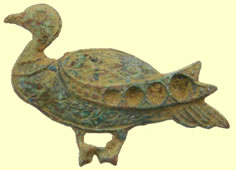 |
 |
|||||||
1217/8 Henry III hammered silver short cross penny - Class 7C Rev NICbOLE ON LV - Moneyer Nicole of London mint |
Victorian bird brooch |
1962 FDR bowling badge |
|||||||
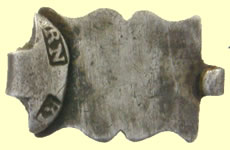 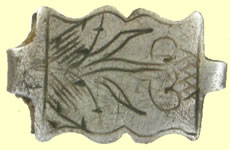 |
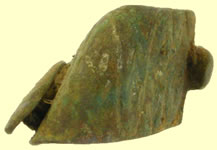 |
 |
|||||||
1760's silver clog fastener - unknown maker RN |
18thC decorated clog fastener |
Georgian ceramic pipe tamper |
|||||||
 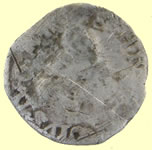 |
 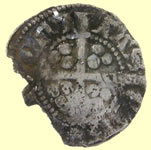 |
||||||||
1634 Charles 1st hammered silver penny |
1341 Edward III hammered silver Florin penny Obv EDW ****** DNS HYB Rev CIVI/TAS/CAN/TOR - Canterbury mint |
||||||||
 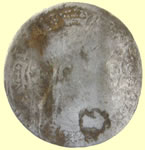 |
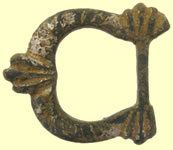 |
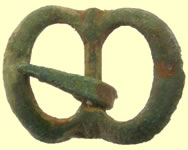 |
|||||||
1696 William III milled silver sixpence |
1500-1650 buckle |
1500-1650 buckle |
|||||||
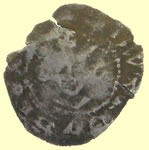 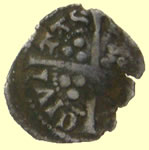 |
 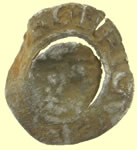 |
||||||||
1272 Edward 1st hammered silver farthing- inner circle both sides - plain cross 3 fleurs Obv EDVVARDVS REX Rev CIVI/TAS -, London mint only 0.27g, 10.47mm |
1194-1205 Richard 1st hammered silver short cross penny - Class 4b Rev STIVENE ON R ? Moneyer Stivene of London mint |
||||||||
 |
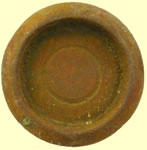 |
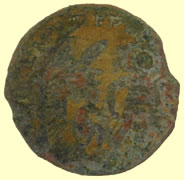 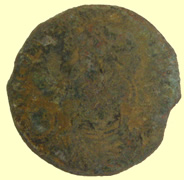 |
|||||||
Georgian watch winder |
First totally unmarked trade weight we have ever found |
Very unusual Roman copper coin sent for ID |
|||||||
17.43mm,1.58g |
|||||||||
17th/18thC Gold posy ring inscribed LOVE VIRTUE HATE VICE Maker WH Reported to museum as possible treasure |
|||||||||
  |
 |
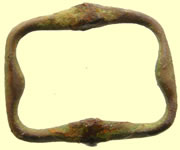 |
|||||||
Medieval clothing fastener |
Fisherman's badge |
Georgian buckle |
|||||||
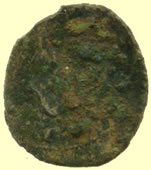  |
  |
||||||||
Mid 4thC Barbarous radiate Roman bronze coin sent for ID |
Medieval cast copper alloy bar mount. Period from: MEDIEVAL Date from: AD 1200
|
||||||||
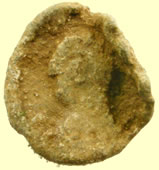 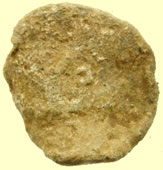 |
  |
||||||||
Roman lead token |
WWI Lead toy Prussian soldier |
||||||||
 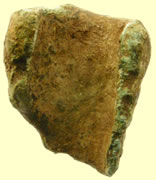 |
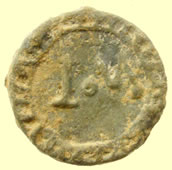 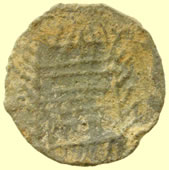 |
||||||||
850BC Bronze Age socketed axe fragment |
17thC lead token |
||||||||
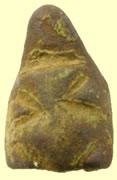 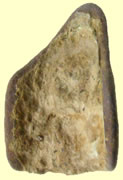 |
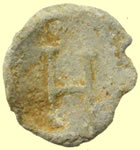 |
||||||||
Saxon Stirrup terminal
Early Medieval 11th century |
17thC lead token |
||||||||
 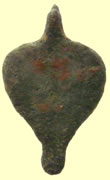 |
 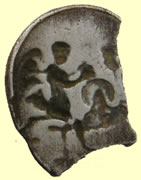 |
||||||||
Roman enameled harness pendant |
17thC silver seal matrix reported as treasure to museum |
||||||||
 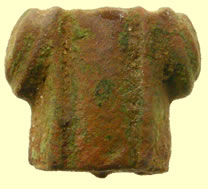 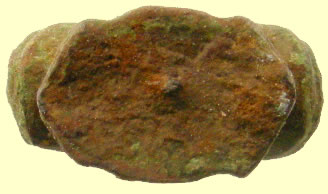 |
|||||||||
Medieval knife pommel |
|||||||||
  |
  |
||||||||
Stunning 2nd Roman enameled head stud type brooch |
Great find 18thC navy watch winder |
||||||||
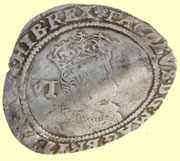 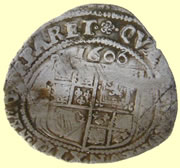 |
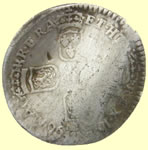  |
||||||||
1605 -6 James 1st hammered silver 6 pence |
1696 William III milled silver sixpence |
||||||||
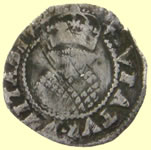 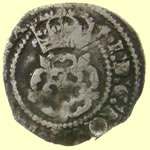 |
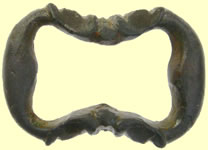 |
 |
|||||||
1618-19 James 1st hammered silver 2 pence |
1500-1700 buckle |
17thC clothing fastener |
|||||||
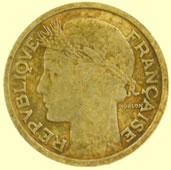 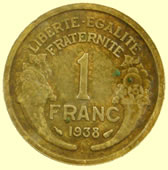 |
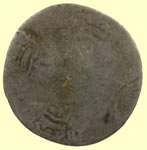 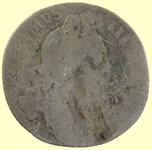 |
||||||||
1939 French 1 Franc coin |
1696 William III milled silver sixpence |
||||||||
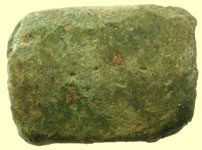  |
|
||||||||
Medieval knife quillion |
Medieval knife quillion |
||||||||
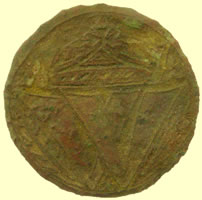  |
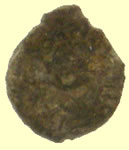  |
||||||||
17thC William of Orange badge - Crown W |
Tiny Roman minim coin sent for ID At first glance, at least, it seems similar to the very late Roman nummi - typically from mid- to late-5th century - the single denomination, the Nummus, 40 of which made a Byzantine follis (with "M" mark of denomination reverse) Although they usually had a portrait on the obverse, and at least part of a legend - they're so small that virtually none of them ever has anything like a complete, legible obverse legend - and the reverses were monograms of the rulers' names.
Not to say that this might not be a Saxon piece in imitation of the types or styles in use on the continent, since the various Gothic successors to the Roman Empire in the West also imitated the coins of the Byzantine Roman Empire - although generally in precious metals - they weren't real big on token coinage as a concept so they tended to make and use tiny silver & gold pieces for small change in the few places coins were still used.
Compare your piece to this Marcian - probably the clearest example I have of an Æ4 with monogram reverse.
So your piece might be Roman, or it might be a contemporary copy of a Roman coin, or it cold be from a Gothic or Saxon series which, in general, imitated Roman/Byzantine types.
I'll be curious to see a clearer close-up - I can then try comparing the reverse against the various monogram charts.
Mark
|
||||||||
 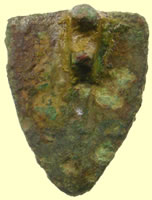 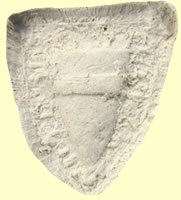 |
|||||||||
14thC Medieval heraldic seal matrix - plain shield with single fesse Tamas de Kent ? |
|||||||||
 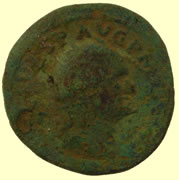 |
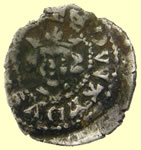  |
||||||||
Roman coin sent for ID |
1300-10 Edward 1st hammered silver farthing Type 28 - new issue with inner circles both sides Obv EDWARDVS REX Rev CIVI/TAS/LON/DON - London mint 0.35g,12.05mm |
||||||||
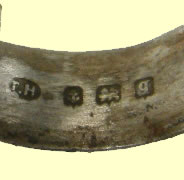 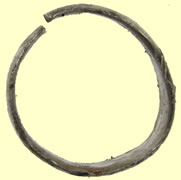 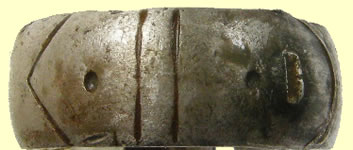 |
|||||||||
Silver ring - 1906 Birmingham mark
|
|||||||||
 |
 |
|
|||||||
1500-1650 buckle |
Georgian buckle |
Huge Roman key |
|||||||
